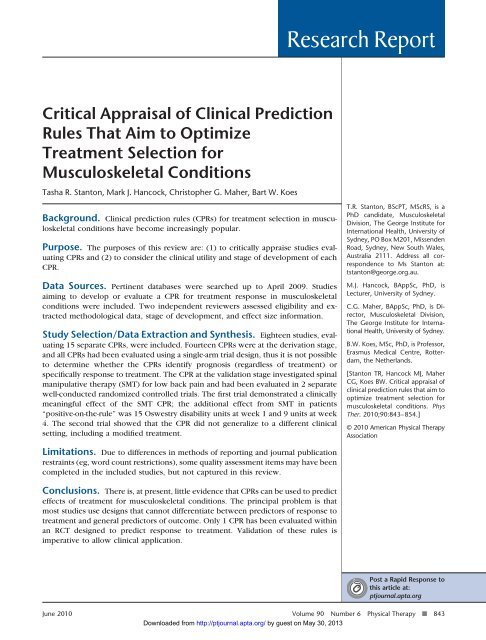Critical Appraisal of Clinical Prediction Rules That Aim to Optimize ...
Critical Appraisal of Clinical Prediction Rules That Aim to Optimize ...
Critical Appraisal of Clinical Prediction Rules That Aim to Optimize ...
Create successful ePaper yourself
Turn your PDF publications into a flip-book with our unique Google optimized e-Paper software.
<strong>Critical</strong> <strong>Appraisal</strong> <strong>of</strong> <strong>Clinical</strong> <strong>Prediction</strong><br />
<strong>Rules</strong> <strong>That</strong> <strong>Aim</strong> <strong>to</strong> <strong>Optimize</strong><br />
Treatment Selection for<br />
Musculoskeletal Conditions<br />
Tasha R. Stan<strong>to</strong>n, Mark J. Hancock, Chris<strong>to</strong>pher G. Maher, Bart W. Koes<br />
Background. <strong>Clinical</strong> prediction rules (CPRs) for treatment selection in musculoskeletal<br />
conditions have become increasingly popular.<br />
Purpose. The purposes <strong>of</strong> this review are: (1) <strong>to</strong> critically appraise studies evaluating<br />
CPRs and (2) <strong>to</strong> consider the clinical utility and stage <strong>of</strong> development <strong>of</strong> each<br />
CPR.<br />
Data Sources. Pertinent databases were searched up <strong>to</strong> April 2009. Studies<br />
aiming <strong>to</strong> develop or evaluate a CPR for treatment response in musculoskeletal<br />
conditions were included. Two independent reviewers assessed eligibility and extracted<br />
methodological data, stage <strong>of</strong> development, and effect size information.<br />
Study Selection/Data Extraction and Synthesis. Eighteen studies, evaluating<br />
15 separate CPRs, were included. Fourteen CPRs were at the derivation stage,<br />
and all CPRs had been evaluated using a single-arm trial design, thus it is not possible<br />
<strong>to</strong> determine whether the CPRs identify prognosis (regardless <strong>of</strong> treatment) or<br />
specifically response <strong>to</strong> treatment. The CPR at the validation stage investigated spinal<br />
manipulative therapy (SMT) for low back pain and had been evaluated in 2 separate<br />
well-conducted randomized controlled trials. The first trial demonstrated a clinically<br />
meaningful effect <strong>of</strong> the SMT CPR; the additional effect from SMT in patients<br />
“positive-on-the-rule” was 15 Oswestry disability units at week 1 and 9 units at week<br />
4. The second trial showed that the CPR did not generalize <strong>to</strong> a different clinical<br />
setting, including a modified treatment.<br />
Limitations. Due <strong>to</strong> differences in methods <strong>of</strong> reporting and journal publication<br />
restraints (eg, word count restrictions), some quality assessment items may have been<br />
completed in the included studies, but not captured in this review.<br />
Conclusions. There is, at present, little evidence that CPRs can be used <strong>to</strong> predict<br />
effects <strong>of</strong> treatment for musculoskeletal conditions. The principal problem is that<br />
most studies use designs that cannot differentiate between predic<strong>to</strong>rs <strong>of</strong> response <strong>to</strong><br />
treatment and general predic<strong>to</strong>rs <strong>of</strong> outcome. Only 1 CPR has been evaluated within<br />
an RCT designed <strong>to</strong> predict response <strong>to</strong> treatment. Validation <strong>of</strong> these rules is<br />
imperative <strong>to</strong> allow clinical application.<br />
Research Report<br />
T.R. Stan<strong>to</strong>n, BScPT, MScRS, is a<br />
PhD candidate, Musculoskeletal<br />
Division, The George Institute for<br />
International Health, University <strong>of</strong><br />
Sydney, PO Box M201, Missenden<br />
Road, Sydney, New South Wales,<br />
Australia 2111. Address all correspondence<br />
<strong>to</strong> Ms Stan<strong>to</strong>n at:<br />
tstan<strong>to</strong>n@george.org.au.<br />
M.J. Hancock, BAppSc, PhD, is<br />
Lecturer, University <strong>of</strong> Sydney.<br />
C.G. Maher, BAppSc, PhD, is Direc<strong>to</strong>r,<br />
Musculoskeletal Division,<br />
The George Institute for International<br />
Health, University <strong>of</strong> Sydney.<br />
B.W. Koes, MSc, PhD, is Pr<strong>of</strong>essor,<br />
Erasmus Medical Centre, Rotterdam,<br />
the Netherlands.<br />
[Stan<strong>to</strong>n TR, Hancock MJ, Maher<br />
CG, Koes BW. <strong>Critical</strong> appraisal <strong>of</strong><br />
clinical prediction rules that aim <strong>to</strong><br />
optimize treatment selection for<br />
musculoskeletal conditions. Phys<br />
Ther. 2010;90:843–854.]<br />
© 2010 American Physical Therapy<br />
Association<br />
Post a Rapid Response <strong>to</strong><br />
this article at:<br />
ptjournal.apta.org<br />
June 2010 Volume 90 Number 6 Physical Therapy f 843<br />
Downloaded from<br />
http://ptjournal.apta.org/ by guest on May 30, 2013
















